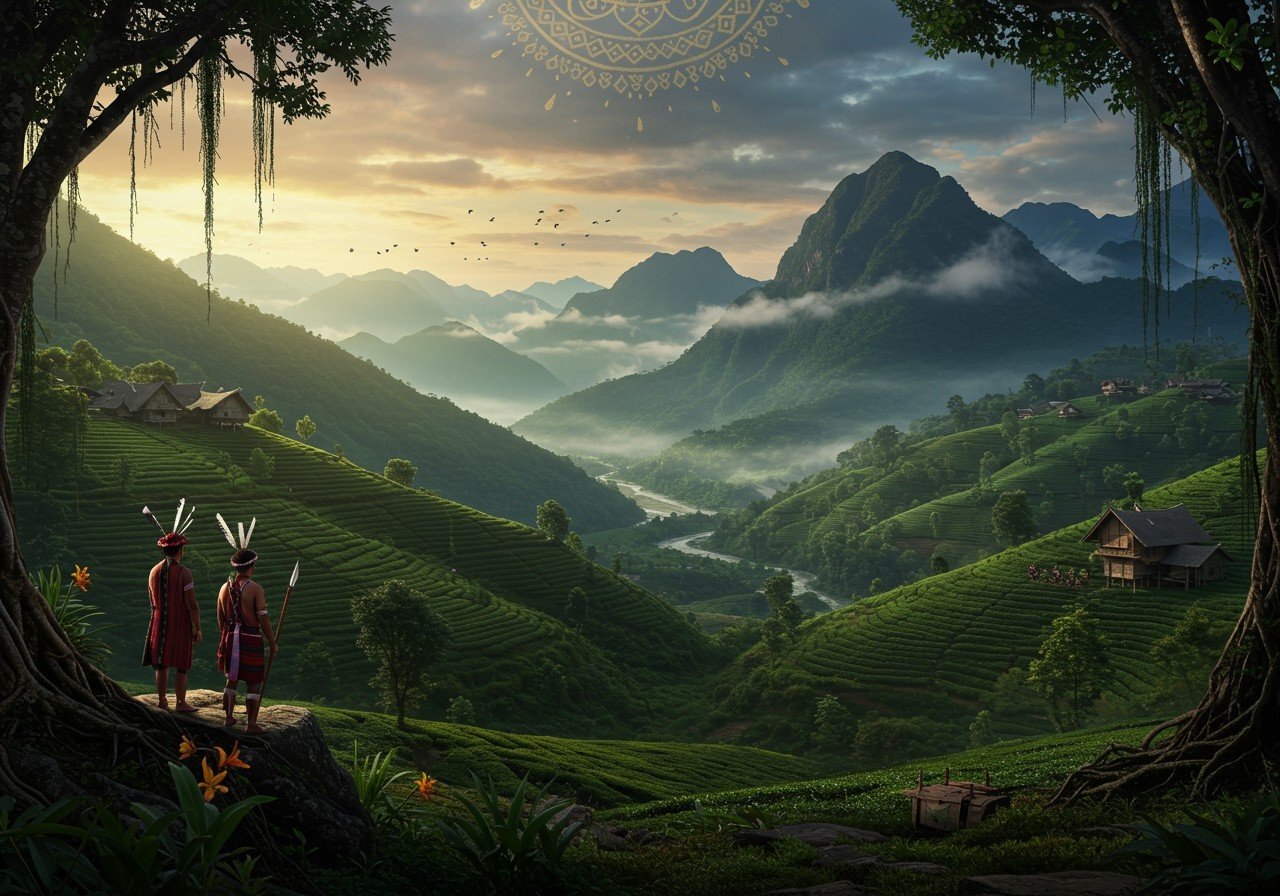
The Patkai Mountain Range, a breathtaking spectacle of nature, stands tall on the Indo-Myanmar border. Nestled in the northeastern states of Arunachal Pradesh, Nagaland, and Assam, it extends into Myanmar’s Upper Burma region. Unlike the towering Himalayas, the Patkais possess a unique charm with lower peaks, deep valleys, conical summits, and steep slopes. This region holds a special place in India’s geography and history, separating us from our neighbors while carrying a rich historical narrative. Understanding the Patkai’s geography and ancient past is especially meaningful for culturally rooted Indians. The unique blend of nature and culture in the Patkai Hills draws those who cherish tradition and authentic rituals.
Geographical Wonders of the Patkai
The Patkai Range is a part of the Purvanchal Range, encompassing sub-ranges like the Patkai-Bum, the Garo-Khasi-Jaintia Hills, and the Lushai Hills. Did you know Mount Saramati, at 3,841 meters, is Nagaland’s highest peak? The elevation across the range varies between 900 to 2,400 meters, resulting in diverse climates, from temperate to alpine. Mawsynram and Cherrapunji, located in the Garo-Khasi-Jaintia hills, are known for their exceptionally high rainfall.
The Patkai Mountains are a treasure trove of biodiversity. Dense tropical and subtropical forests teem with life, sheltering a rich variety of flora and fauna. Mishmi teak and vibrant orchids thrive here, alongside fascinating creatures like red pandas and hoolock gibbons. The range is also the source of several important rivers, including the Budhidihing, Nadihing, Namphuk, Tirap, and Dibang. These rivers are lifelines for the region’s ecosystem.
A Journey Through Patkai’s History
The story of the Patkai Mountains is as captivating as its scenery. Born from the collision of the Indian and Eurasian tectonic plates, the range belongs to the Eastern Himalayan family. This tectonic activity has sculpted not just the landscape but also the lives of numerous indigenous tribes. The hills have served as both a vital trade route and a formidable natural barrier. They have connected diverse cultures and communities, facilitating exchanges that have enriched the region’s heritage. For instance, the Patkai played a crucial role in Assam’s history when Chaolung Sukaphaa crossed these hills in the 13th century to establish the Ahom kingdom.
During World War II, the Patkai Mountains took on strategic significance with the building of the Ledo Road (also known as the Stilwell Road). This road, crossing through Pangsau Pass, linked India with the Burma Road and China. Known as “The Hump” by Allied Forces, this route proved vital for their operations.
The cultural importance of the Patkai Hills is deeply rooted. Home to many indigenous tribes, such as the Naga, Mishmi, and Singpho, each with its unique customs and traditions. The name “Patkai” itself comes from ‘Pat-kai-chang-kan,’ a phrase referencing a religious ceremony symbolizing a war and subsequent peace treaty in 1401 AD between the Nara King Surupha of Mogaung and the Ahom King Sudangpha. This historical event emphasizes the cultural weight carried by these mountains.
Patkai Dun: A Unique Landscape
Within this majestic range lies Patkai Dun, a geographical gem characterized by valleys, rivers, and lush forests. This area is an ecological haven supporting a rich diversity of wildlife. However, threats like deforestation and climate change loom large, impacting the delicate balance of this ecosystem. Conservation efforts are crucial to safeguard this area’s natural beauty for future generations. Community-led initiatives are gaining momentum, focusing on protecting this invaluable environment and its biodiversity.
Poojn.in: Connecting You to Patkai’s Sacred Heritage
Poojn.in offers authentic puja items that resonate with the spiritual significance of the Patkai region. We bridge ancient traditions with modern convenience. As India’s largest Dashakarma bhandar, we offer:
- Traditional prayer items used in rituals specific to Northeast Indian customs, allowing you to connect with the rich spiritual heritage of the region.
- Pure copper and brass items that reflect the metalwork traditions of the Patkai region, bringing the artistry and craftsmanship of the area into your home.
- Natural incense and dhoop sourced from the aromatic plants of the mountain range, creating a sacred and calming atmosphere for your prayers and meditations. Explore our range of dhoop.
- Handcrafted puja thalis made by local artisans following age-old designs. Our thalis, beautifully crafted and imbued with tradition, add a touch of authenticity to your puja rituals. Discover our collection of puja thalis.
To discover more about our collection of ritual items connected to Patkai’s sacred traditions, visit www.poojn.in. Our knowledgeable team is happy to assist you:
- Call: 03369029784
- WhatsApp: 9476142738
We deliver across India, bringing the sanctity of tradition to your doorstep. Each product is carefully chosen to uphold the integrity of traditional rituals while offering the convenience of online shopping.
Note: For specific product availability and current prices, please check our website or contact our customer service team.
Embracing Patkai’s Enduring Legacy
The Patkai Mountain Range represents a unique fusion of nature, history, and culture. As we admire its majestic hills and draw wisdom from its past, we connect with India’s vibrant heritage. The biodiverse landscapes, teeming with rare flora and fauna, remind us of nature’s beauty and fragility. From ancient trade routes to World War II strategies, the range’s historical significance is undeniable, showcasing its impact on human lives and cultures. Today, the Patkai continues to evoke awe and respect. Conservation efforts are essential to protect its natural splendor and rich cultural heritage. Community-led initiatives and responsible tourism can help safeguard this treasure for generations to come. By embracing the legacy of the Patkai, we honor the traditions of yesterday and build a sustainable tomorrow. Let’s celebrate and protect this remarkable mountain range, a symbol of our shared heritage and our commitment to preserving our planet’s wonders.
Frequently Asked Questions About the Patkai Mountains
What makes the Patkai Hills so special?
The Patkai Hills are significant as a natural border between India and Myanmar, a biodiversity hotspot, and a region with a captivating history going back centuries. Their role in shaping regional climate and geography adds to their importance.
How do the Patkai Hills form a natural barrier?
The Patkai Hills create a natural division between India and Myanmar, influencing the climate and geographical features on either side. Their presence has impacted the cultural development of the region as well.
What insights can you share about the ancient history of the Patkai Hills?
The ancient history of the Patkai Hills speaks of early tribal settlements and the interplay of diverse cultures. The hills have witnessed countless historical events and served as a point of convergence for different ethnic groups, creating a rich tapestry of human experience. Learn more about ancient history.
Why are the Patkai Hills relevant for the UPSC exam?
The Patkai Hills are essential for the UPSC exam as a key geographical feature of India. Knowing their location, climatic influence, and historical significance is vital for navigating questions on Indian geography and history. A comprehensive understanding of this region is a valuable asset for UPSC aspirants. Explore further UPSC related information here.
Could you explain what Patkai Dun is and its location?
Patkai Dun is a valley nestled within the Patkai Hills, known for its distinctive topography. It plays a significant role in the regional ecology and climate. Its unique features contribute to the biodiversity and environmental balance of the surrounding area.
How do the Patkai Hills affect the regional climate?
The Patkai Hills have a substantial impact on the regional climate by obstructing cold winds and shaping rainfall patterns. This influence creates lush environments and sustains diverse ecosystems. The hills’ role in moderating temperature and precipitation is crucial for the region.
What kind of biodiversity thrives in the Patkai Hills?
The Patkai Hills are a haven for diverse flora and fauna. Their dense forests provide shelter for various wildlife species, making them a focal point for conservation efforts. Protecting this rich biodiversity is essential for maintaining ecological balance.
Do any notable tribes call the Patkai Hills home?
Yes, the Patkai Hills are home to several indigenous tribes, each with a unique culture and traditions passed down through generations. They contribute to the rich cultural tapestry of the region, showcasing the diversity and heritage of India’s Northeast. Discover more about tribal cultures here. Explore the impact of Ramayana on Indian culture.


